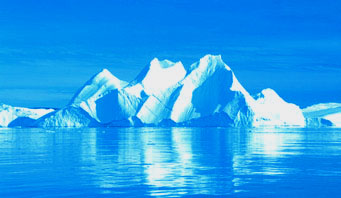Alaska
- Antarctica - tundra  |
|
Alaska's cold desert
Alaska’s Arctic is a vast wilderness which provides vital habitat for hundreds of animal species including bears, wolves, caribou, musk oxen, and
millions of migratory birds. And for those human visitors who sustain themselves on the beauty and solitude of the wilderness, the Arctic provides
a chance to escape from the pressures of modern society as well as the knowledge that such remote and awe-inspiring places still exist |
| Alaska Geobotany Center Arctic Maps, Alaska Geobotany Center, maps, vegetation,
vegetation maps, Alaska, Arctic, Circumpolar, geobotany, Circumpolar Arctic
Vegetation Mapping, CAVM, atlas, cryoturbation, bioclimatic zones,
Circumpolar Maps, down? |
| Alaska
wildlife images Alaska wildlife images |
| Alaskan
volcano observatory |
| Alaska environmental
center Alaska's Arctic has been called the last great wilderness |
|
Amundsen-Scott South Pole Station (Bill Spindler's Antarctica) |
|
Antarctica Antarctica is the coldest, windiest, iciest and most remote continent on our planet. It's one of the most difficult and dangerous places
to visit, and yet one of the most fascinating and instructive |
| Antarctica.org.nz |
| Antarctic
and Arctic icebergs |
| Antarctic experience
a tip |
| Arctic circle
the Arctic Ocean is the centerpiece of the circumpolar north. Lands bordering this region include those of Alaska, Canada, Greenland and
Denmark, Iceland, Norway, Sweden, Finland, and Russia |
| Arctic and Antarctica
the Antarctic continent is surrounded by oceans, winds, and circumpolar currents, uninterrupted by land masses. The Arctic ocean is surrounded by
continents, a tip |
|
Arctic glossary
Northern polar region of the Earth which includes almost the whole area of
the Arctic ocean and adjacent areas of Eurasian and North American
continents |
| Castles
of ice
During the peak of the last ice age, one-third of the Earth's
land surface was covered by thick sheets of ice. Their high albedo reflected
a great deal of sunlight out into space, which cooled Earth and allowed the
ice sheets to grow. (See our Ice Ages web page.) Ice sheets give birth to
icebergs |
|
Conservation of Arctic flora and fauna
it mission is to conserve Arctic biodiversity and to ensure that the use of Arctic living resources is sustainable |
| Coastal change and glaciological
maps of Antarctica |
| Crevasse zone
Crevasse zone, GPS glacier surface movement and elevation surveys on the Juneau
icefield, Alaska |
| Cryosphere:
where the world is frozen |
|
Educapoles les régions polaires, le cycle de l'eau et les glaces sur la Terre, le climat et les changements climatiques, en
Français, animations |
|
Glacial geology a tip |
|
Glacial systems the two basic types of glaciers, continental and alpine,
form and impact the topography of the earth |
|
Glacier
Glacier |
|
Glacier
A glacier is a perennial mass of ice which moves over land. A glacier forms
in locations where the mass accumulation of snow and ice exceeds ablation
over many years |
|
Glacier
glacier facts, questions and answers, a glossary, a gallery, bibliography
and links to glacier information on the web |
|
Antartica in the winter, the lowest recorded temperatures (without wind chill!) have reached -89°C (-129°F). The continent averages 2.4 kilometers
in height (1.5 miles) above sea level, making it 1.5 kilometers (almost a mile) higher than the global average land height! |
|
Glaciers Glacier animation |
|
Glaciers and glaciations |
|
Glaciers and the
glacial ages glaciers are large masses of snow, recrystallized ice and
rock debris that accumulate in great quantities and begin to flow outwards
and downwards under the pressure of their own weight, Educypedia |
|
Glaciers
exploring nearly all aspects of glaciers including data and
science, facts, a gallery, a glossary and much more |
|
Glaciers |
|
Glaciology
Glaciology |
| Green
icebergs |
| Iceberg photographs |
| Icebergs an iceberg is a floating mass of freshwater ice that has broken from the seaward end of a glacier or a polar ice sheet. Icebergs are
typically found in open seas, especially around Greenland and Antarctica |
| Icebergs
a majority of the icebergs in the North Atlantic come from about 100 iceberg producing glaciers along the Greenland coast while a few originate in the
Eastern Canadian Arctic Islands |
|
Icebergs and glaciers an iceberg is a mass of ice that has broken off part of a glacier called calcen and has fallen into a nearby body of water |
| Nearctica the
plants, animals, or the physical environment of North America |
| Nova- Antarctic
almanac Antarctica has some seven million cubic miles of ice, representing some 90 percent of the world's total |
|
Satellite
image atlas of glaciers of the world |
|
Snow, Ice, and
Permafrost Glaciology, Permafrost, Sea Ice, Snow |
| Tundra
the tundra is the coldest and the driest of all the biomes on Earth. This biome lies above the Arctic Ocean in the world's highest northern latitudes.
The tundra covers about one fifth of the land surface found on Earth. These low swampy plains are found in Northern Europe, Siberia, Northern most part
of North America, and a few places in the southern hemisphere |
| Tundra
animals |
| Warnings
from the ice white continent, icecore, radioactivity, chernobyl, fallout,
south pole, air pollution, climate change, temperature, volcanoes,
volcanic eruption, global warming, greenhouse, gases, glacier, Antarctic, circumpolar,
antifreeze, glycopeptides, growler, katabatic, neve, nilas, nunatak, polynya, satsrugi |
| Wildlife of Antarctica
no land-based vertebrate animals inhabit Antarctica. Invertebrates, especially mites and ticks, which can tolerate the lower temperatures, exist
in the Antarctic Peninsula but are still considered rare. The surrounding ocean, however, abounds in living creatures |
|
Horizontaal |
|
|
 |
|
|
Home
|
Site Map
|
Email: support[at]karadimov.info
Last updated on:
2011-01-02
|
Copyright © 2011-2021 Educypedia.
http://educypedia.karadimov.info
|
| |